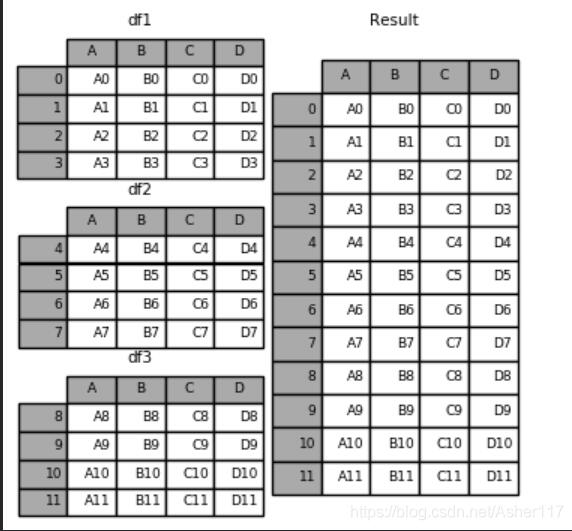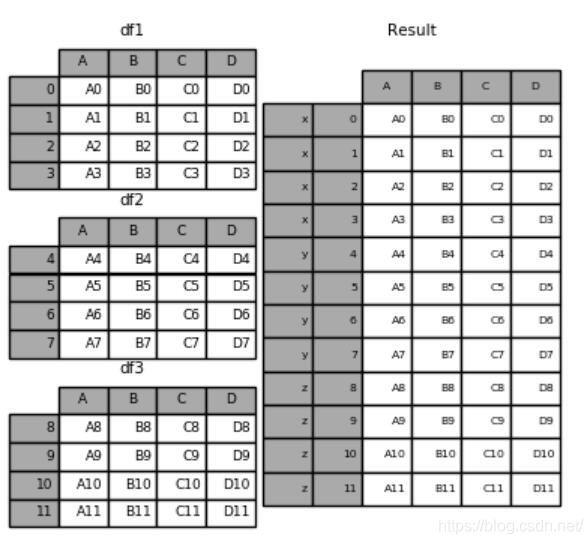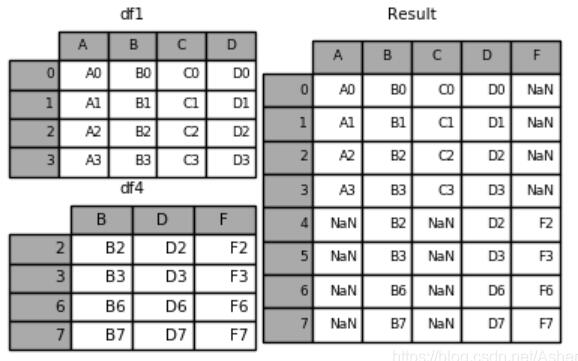Python3 pandas.concat使用 Python3 pandas.concat的用法说明
Asher117 人气:0前面给大家分享了pandas.merge用法详解,这节分享pandas数据合并处理的姊妹篇,pandas.concat用法详解,参考利用Python进行数据分析与pandas官网进行整理。
pandas.merge参数列表如下图,其中只有objs是必须得参数,另外常用参数包括objs、axis、join、keys、ignore_index。

1.pd.concat([df1,df2,df3]), 默认axis=0,在0轴上合并。

2.pd.concat([df1,df4],axis=1)–在1轴上合并

3.pd.concat([df1,df2,df3],keys=[‘x', ‘y', ‘z'])–合并时便于区分建立层次化索引。

4.pd.concat([df1, df4], axis=1, join=‘inner')–采用内连接合并,join默认为outer外连接。

5.pd.concat([df1, df4], ignore_index=True)–当原来DataFrame的索引没有意义的时候,concat之后可以不需要原来的索引。

补充:python3:pandas(合并concat和merge)
pandas处理多组数据的时候往往会要用到数据的合并处理,其中有三种方式,concat、append和merge。
1、concat
用concat是一种基本的合并方式。而且concat中有很多参数可以调整,合并成你想要的数据形式。axis来指明合并方向。axis=0是预设值,因此未设定任何参数时,函数默认axis=0。(0表示上下合并,1表示左右合并)
import pandas as pd import numpy as np #定义资料集 df1 = pd.DataFrame(np.ones((3,4))*0, columns=['a','b','c','d']) df2 = pd.DataFrame(np.ones((3,4))*1, columns=['a','b','c','d']) df3 = pd.DataFrame(np.ones((3,4))*2, columns=['a','b','c','d']) #concat纵向合并 res = pd.concat([df1, df2, df3], axis=0) #打印结果 print(res) ''' a b c d 0 0.0 0.0 0.0 0.0 1 0.0 0.0 0.0 0.0 2 0.0 0.0 0.0 0.0 0 1.0 1.0 1.0 1.0 1 1.0 1.0 1.0 1.0 2 1.0 1.0 1.0 1.0 0 2.0 2.0 2.0 2.0 1 2.0 2.0 2.0 2.0 2 2.0 2.0 2.0 2.0 '''
上述index为0,1,2,0,1,2形式。为什么会出现这样的情况,其实是仍然按照合并前的index组合起来的。若希望递增,请看下面示例:
ignore_index (重置 index)
重置后的index为0,1,……8
res = pd.concat([df1, df2, df3], axis=0, ignore_index=True)# 将ignore_index设置为True print(res) #打印结果 ''' a b c d 0 0.0 0.0 0.0 0.0 1 0.0 0.0 0.0 0.0 2 0.0 0.0 0.0 0.0 3 1.0 1.0 1.0 1.0 4 1.0 1.0 1.0 1.0 5 1.0 1.0 1.0 1.0 6 2.0 2.0 2.0 2.0 7 2.0 2.0 2.0 2.0 8 2.0 2.0 2.0 2.0 '''
join (合并方式)
join='outer'为预设值,因此未设定任何参数时,函数默认join='outer'。此方式是依照column来做纵向合并,有相同的column上下合并在一起,其他独自的column个自成列,原本没有值的位置皆以NaN填充。
import pandas as pd import numpy as np #定义资料集 df1 = pd.DataFrame(np.ones((3,4))*0, columns=['a','b','c','d'], index=[1,2,3]) df2 = pd.DataFrame(np.ones((3,4))*1, columns=['b','c','d','e'], index=[2,3,4]) res = pd.concat([df1, df2], axis=0, join='outer') #纵向"外"合并df1与df2 print(res) ''' a b c d e 1 0.0 0.0 0.0 0.0 NaN 2 0.0 0.0 0.0 0.0 NaN 3 0.0 0.0 0.0 0.0 NaN 2 NaN 1.0 1.0 1.0 1.0 3 NaN 1.0 1.0 1.0 1.0 4 NaN 1.0 1.0 1.0 1.0 ''' res = pd.concat([df1, df2], axis=0, join='inner') #纵向"内"合并df1与df2 #打印结果 print(res) ''' b c d 1 0.0 0.0 0.0 2 0.0 0.0 0.0 3 0.0 0.0 0.0 2 1.0 1.0 1.0 3 1.0 1.0 1.0 4 1.0 1.0 1.0 '''
join_axes (依照 axes 合并)
import pandas as pd import numpy as np #定义资料集 df1 = pd.DataFrame(np.ones((3,4))*0, columns=['a','b','c','d'], index=[1,2,3]) df2 = pd.DataFrame(np.ones((3,4))*1, columns=['b','c','d','e'], index=[2,3,4]) #依照`df1.index`进行横向合并 res = pd.concat([df1, df2], axis=1, join_axes=[df1.index]) #打印结果 print(res) # a b c d b c d e # 1 0.0 0.0 0.0 0.0 NaN NaN NaN NaN # 2 0.0 0.0 0.0 0.0 1.0 1.0 1.0 1.0 # 3 0.0 0.0 0.0 0.0 1.0 1.0 1.0 1.0
上述脚本中,join_axes=[df1.index]表明按照df1的index来合并,可以看到结果中去掉了df2中出现但df1中没有的index=4这一行。
2、append (添加数据)
append只有纵向合并,没有横向合并。
import pandas as pd import numpy as np #定义资料集 df1 = pd.DataFrame(np.ones((3,4))*0, columns=['a','b','c','d']) df2 = pd.DataFrame(np.ones((3,4))*1, columns=['a','b','c','d']) df3 = pd.DataFrame(np.ones((3,4))*1, columns=['a','b','c','d']) s1 = pd.Series([1,2,3,4], index=['a','b','c','d']) #将df2合并到df1的下面,以及重置index,并打印出结果 res = df1.append(df2, ignore_index=True) print(res) # a b c d # 0 0.0 0.0 0.0 0.0 # 1 0.0 0.0 0.0 0.0 # 2 0.0 0.0 0.0 0.0 # 3 1.0 1.0 1.0 1.0 # 4 1.0 1.0 1.0 1.0 # 5 1.0 1.0 1.0 1.0 #合并多个df,将df2与df3合并至df1的下面,以及重置index,并打印出结果 res = df1.append([df2, df3], ignore_index=True) print(res) # a b c d # 0 0.0 0.0 0.0 0.0 # 1 0.0 0.0 0.0 0.0 # 2 0.0 0.0 0.0 0.0 # 3 1.0 1.0 1.0 1.0 # 4 1.0 1.0 1.0 1.0 # 5 1.0 1.0 1.0 1.0 # 6 1.0 1.0 1.0 1.0 # 7 1.0 1.0 1.0 1.0 # 8 1.0 1.0 1.0 1.0 #合并series,将s1合并至df1,以及重置index,并打印出结果 res = df1.append(s1, ignore_index=True) print(res) # a b c d # 0 0.0 0.0 0.0 0.0 # 1 0.0 0.0 0.0 0.0 # 2 0.0 0.0 0.0 0.0 # 3 1.0 2.0 3.0 4.0
3、merge
根据两组数据中的关键字key来合并(key在两组数据中是完全一致的)。
3.1依据一组key合并
import pandas as pd
#定义资料集并打印出
left = pd.DataFrame({'key': ['K0', 'K1', 'K2', 'K3'],
'A': ['A0', 'A1', 'A2', 'A3'],
'B': ['B0', 'B1', 'B2', 'B3']})
right = pd.DataFrame({'key': ['K0', 'K1', 'K2', 'K3'],
'C': ['C0', 'C1', 'C2', 'C3'],
'D': ['D0', 'D1', 'D2', 'D3']})
print(left)
# A B key
# 0 A0 B0 K0
# 1 A1 B1 K1
# 2 A2 B2 K2
# 3 A3 B3 K3
print(right)
# C D key
# 0 C0 D0 K0
# 1 C1 D1 K1
# 2 C2 D2 K2
# 3 C3 D3 K3
#依据key column合并,并打印出
res = pd.merge(left, right, on='key')
print(res)
A B key C D
# 0 A0 B0 K0 C0 D0
# 1 A1 B1 K1 C1 D1
# 2 A2 B2 K2 C2 D2
# 3 A3 B3 K3 C3 D3
3.2 根据两组key合并
合并时有4种方法how = ['left', 'right', 'outer', 'inner'],预设值how='inner'。
inner:按照关键字组合之后,去掉组合中有合并项为NaN的行。
outer :保留所有组合
left:仅保留左边合并项为NaN的行
right:仅保留右边合并项为NaN的行
import pandas as pd
import numpy as np
#定义资料集并打印出
left = pd.DataFrame({'key1': ['K0', 'K0', 'K1', 'K2'],
'key2': ['K0', 'K1', 'K0', 'K1'],
'A': ['A0', 'A1', 'A2', 'A3'],
'B': ['B0', 'B1', 'B2', 'B3']})
right = pd.DataFrame({'key1': ['K0', 'K1', 'K1', 'K2'],
'key2': ['K0', 'K0', 'K0', 'K0'],
'C': ['C0', 'C1', 'C2', 'C3'],
'D': ['D0', 'D1', 'D2', 'D3']})
print(left)
'''
key1 key2 A B
0 K0 K0 A0 B0
1 K0 K1 A1 B1
2 K1 K0 A2 B2
3 K2 K1 A3 B3
'''
print(right)
'''
key1 key2 C D
0 K0 K0 C0 D0
1 K1 K0 C1 D1
2 K1 K0 C2 D2
3 K2 K0 C3 D3
'''
#依据key1与key2 columns进行合并,并打印出四种结果['left', 'right', 'outer', 'inner']
res = pd.merge(left, right, on=['key1', 'key2'], how='inner')
print(res)
'''
key1 key2 A B C D
0 K0 K0 A0 B0 C0 D0
1 K1 K0 A2 B2 C1 D1
2 K1 K0 A2 B2 C2 D2
'''
res = pd.merge(left, right, on=['key1', 'key2'], how='outer')
print(res)
'''
key1 key2 A B C D
0 K0 K0 A0 B0 C0 D0
1 K0 K1 A1 B1 NaN NaN
2 K1 K0 A2 B2 C1 D1
3 K1 K0 A2 B2 C2 D2
4 K2 K1 A3 B3 NaN NaN
5 K2 K0 NaN NaN C3 D3
'''
res = pd.merge(left, right, on=['key1', 'key2'], how='left')
print(res)
'''
key1 key2 A B C D
0 K0 K0 A0 B0 C0 D0
1 K0 K1 A1 B1 NaN NaN
2 K1 K0 A2 B2 C1 D1
3 K1 K0 A2 B2 C2 D2
4 K2 K1 A3 B3 NaN NaN
'''
res = pd.merge(left, right, on=['key1', 'key2'], how='right')
print(res)
'''
key1 key2 A B C D
0 K0 K0 A0 B0 C0 D0
1 K1 K0 A2 B2 C1 D1
2 K1 K0 A2 B2 C2 D2
3 K2 K0 NaN NaN C3 D3
'''
3.3 Indicator
indicator=True会将合并的记录放在新的一列。
import pandas as pd
#定义资料集并打印出
df1 = pd.DataFrame({'col1':[0,1], 'col_left':['a','b']})
df2 = pd.DataFrame({'col1':[1,2,2],'col_right':[2,2,2]})
print(df1)
# col1 col_left
# 0 0 a
# 1 1 b
print(df2)
# col1 col_right
# 0 1 2
# 1 2 2
# 2 2 2
# 依据col1进行合并,并启用indicator=True,最后打印出
res = pd.merge(df1, df2, on='col1', how='outer', indicator=True)
print(res)
# col1 col_left col_right _merge
# 0 0.0 a NaN left_only
# 1 1.0 b 2.0 both
# 2 2.0 NaN 2.0 right_only
# 3 2.0 NaN 2.0 right_only
# 自定indicator column的名称,并打印出
res = pd.merge(df1, df2, on='col1', how='outer', indicator='indicator_column')
print(res)
# col1 col_left col_right indicator_column
# 0 0.0 a NaN left_only
# 1 1.0 b 2.0 both
# 2 2.0 NaN 2.0 right_only
# 3 2.0 NaN 2.0 right_only
3.4 依据index合并
import pandas as pd
#定义资料集并打印出
left = pd.DataFrame({'A': ['A0', 'A1', 'A2'],
'B': ['B0', 'B1', 'B2']},
index=['K0', 'K1', 'K2'])
right = pd.DataFrame({'C': ['C0', 'C2', 'C3'],
'D': ['D0', 'D2', 'D3']},
index=['K0', 'K2', 'K3'])
print(left)
# A B
# K0 A0 B0
# K1 A1 B1
# K2 A2 B2
print(right)
# C D
# K0 C0 D0
# K2 C2 D2
# K3 C3 D3
#依据左右资料集的index进行合并,how='outer',并打印出
res = pd.merge(left, right, left_index=True, right_index=True, how='outer')
print(res)
# A B C D
# K0 A0 B0 C0 D0
# K1 A1 B1 NaN NaN
# K2 A2 B2 C2 D2
# K3 NaN NaN C3 D3
#依据左右资料集的index进行合并,how='inner',并打印出
res = pd.merge(left, right, left_index=True, right_index=True, how='inner')
print(res)
# A B C D
# K0 A0 B0 C0 D0
# K2 A2 B2 C2 D2
3.5 解决overlapping的问题
下面脚本中,boys和girls均有属性age,但是两者值不同,因此需要在合并时加上后缀suffixes,以示区分。
import pandas as pd
#定义资料集
boys = pd.DataFrame({'k': ['K0', 'K1', 'K2'], 'age': [1, 2, 3]})
girls = pd.DataFrame({'k': ['K0', 'K0', 'K3'], 'age': [4, 5, 6]})
#使用suffixes解决overlapping的问题
res = pd.merge(boys, girls, on='k', suffixes=['_boy', '_girl'], how='inner')
print(res)
# age_boy k age_girl
# 0 1 K0 4
# 1 1 K0 5
以上是pandas中有关于合并的一些操作。当然,如果练习的多了,几个方法也是大同小异。希望大家多多支持。如有错误或未考虑完全的地方,望不吝赐教。
加载全部内容